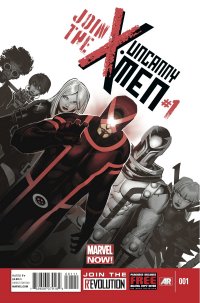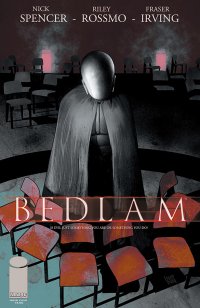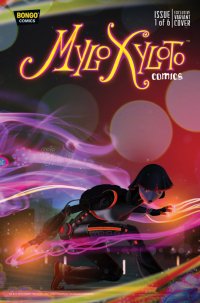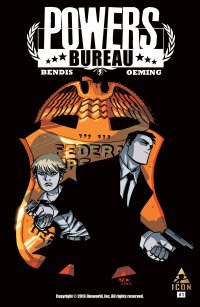UNCANNY X-MEN #1 (Marvel Comics, $3.99)
By Devon Sanders (@devonsanders)
The Uncanny X-Men and I go way back. The very first issue I bought was in a Greyhound bus station on my way to North Carolina. The trip was a long one and I was the type of child who liked to ask lots of questions and in order to keep me quiet for even a second a surefire way to do so was to hand me a comic. I chose Uncanny X-Men #138 and for a few reason; one, the cover was pink. Who puts pink on a comic book cover? Two, the cover had covers in it! Revolutionary! Three, what kid wouldn’t want a shot at $3,000 worth of toys and four, Cyclops was leaving The X-Men. I had no idea who Cyclops was or why he was leaving. Intrigued.
My first encounter with Cyclops was him walking away from The X-Men. The very next time I picked up an X-Men comic, Cyclops challenged a de-powered Storm for leadership of The X-Men, got his ass kicked and left again. Here I am, nearly 25-plus years later, reviewing Uncanny X-Men #1, a comic where Cyclops has left The X-Men following his killing of Professor X. The theme here? Cyclops leaves. A lot.
This time though, he’s left jail (escaped), been branded as a terrorist and is currently running around with former enemies, Magneto and Emma Frost and former New Mutant, Magik, in a quest to save young mutants from persecution. All the while doing so while his powers are all screwy and did I mention he’s been branded as a terrorist?
If you’ve been following Marvel’s latest reboot initiative, Marvel NOW, you know this is the culmination of two years of set-up and frankly, this issue was a bit of a letdown. The story itself isn’t a bad one. Writer Brian Michael Bendis does what he does and explains away everything well. You feel caught up but the struggle, once again, is in the narrative. There’s almost too much of it. What Bendis does do well is set up an ending worth exploring, especially if you’re a fan of hero/villain role reversal.
Artist Chris Bachalo does a great job establishing the chaotic world Cyclops has built for his Uncanny X-Men. Sentinels are rendered large and full of foreboding, rubble is everywhere, perspective is skewed and the costume redesigns are full of threat and menace.
Uncanny X-Men #1 wasn’t terrible. Not at all. It was a Cyclops story. And the thing about a Cyclops story is that you, the reader, knows what he doesn’t. He’s Cyclops. He’s doomed; set up to have his ass handed to him and can’t even see it. Uncanny X-Men #1, in that regard, is excellent in that it simply invites you to the fall.
Rating: 




Out of a Possible 5 Stars
 Bedlam #4 (Image, $3.50)
Bedlam #4 (Image, $3.50)
by Graig Kent
The subtitle of Bedlam reads: “Is evil just something you are or something you do?” It’s the question at the heart of this series which takes a Tarantino-esque approach to thriller (sub-genre: serial killer) storytelling. By that I mean it very liberally borrows from its genre forefathers, completely bathed in homage, but also transcending it.
The first two issues of the series were quite a head trip. The obvious set-up was a Batman-Joker dynamic within the fictional city of Bedlam, however with the Joker character, Madder Red, pushing to ever more drastic extremes to provoke not just the city’s champion (The First) or its police, but the city as a whole. Madder Red’s final act was a grand scheme to try and make the good people of Bedlam more like him, violent and murderous, seemingly committing suicide in the process. But despite the masked head rolling around on the floor Madder Red did not die. Instead he found himself in the care of The Good Doctor who has seen fit to try and “deprogram” Madder Red’s psychotic tendencies, to make him into a viable, average person, named Fillmore. After a decade of treatment, now cooped up in a bachelor apartment, Fillmore becomes obsessed with a recent serial killing case on the news. He wants to help out, by engaging with Detective Ramira Acevedo but can only do so by taking credit for the killings.
However, these gruesome murders aren’t being done by Fillmore, but a scarred, genital-less man with a pair of iron wings. There’s a connective thread to his murders, but the police can’t figure it out while the bodies pile up. Fillmore — the former Madder Red ten years and countless psychological experiments later — becomes suspect number one, given his quickly rescinded confession, but he’s really just there to help. It’s a definite toying of with the Silence of the Lambs structure in this regard, as it plays to the similar thriller aspects, rather than murder mystery.
The overall structure of Bedlam is a bizarre one. The first extra-sized issue, dealt primarily with setting up Madder Red as psycho-supreme in the city, with a diversion into his rehabilitation. The second issue dives into the serial killer story set-up, while exploring Fillmore’s fragile state of mind. The third issue brings forward more of Madder Red’s past therapy, while establishing the relationship between Detective Acevedo and the profiling-savant Fillmore. This issue, unlike the others, is completely story driven, following Avecedo as she cracks the case (Fillmore, meanwhile is on the roof getting re-acquainted with The First), perhaps far too late.
Having read quite a bit of Nick Spencer’s increasingly prolific output of the past two or three years, I can say this is both par for the course for him, the way he jumps around in focus from issue to issue, but also a surprising change. He seems to be experimenting with how he dispenses information and details, and ratchets up the complexity of the structure, the timelines purposefully blurred. However as the series settles, the puzzle pieces are easier to join and the picture is forming nicely, especially here as the series goes from blunt to pointed and sharp.
At the heart of this book is it’s sub-title, examining whether a mass murder can be reformed of his tendencies or if they are embedded within him, while at the same time a damaged man commits increasingly horrific acts, but is evil in his nature or a response some other stimulus? I doubt Spencer has the answer, and I’m not even certain if he’s attempting to answer it. The subtitle seems to be something meant to rattle around in your brain as you read it. I can see a lot of this stemming from the recent (and not so recent) spate of mass killings that have occurred, and Spencer prodding the topic without taking direct focus on any one situation or person.
Artist Riley Rossmo is responsible for portraying the rather dramatic and frequently grizzly imagery in the series, full scope, pencils to colours. His work in the first three issues was insane, particularly his deft restraint with colour in the flashback sequences. The black-and-white-and-red sequences involving Madder Red and his transitionary treatments are both disturbing and attractive at the same time. I keep going back to them. This issue didn’t feature any and fell a little flatter as a result. The jarring break those single-colour sequences provided in the book is missed here, though Rossmo’s constant experimentation with line and colour keep things more than interesting enough. His figure work can feel pretty stilted at times, but the overall effectiveness of the disarming FIncher-esque mood he establishes on every page quite makes up for minor shortcomings.
While it’s hard to disparage the Batman and Joker relationship right now (give the incredible conclusion to “Death of the Family” in the Batman title this week) Spencer has crafted a stimulating twist on it, taking it somewhere deeper and darker he probably couldn’t have gone with DC’s characters. Bedlam is a sober, moody, chilling and graphic bit of business, which, depending on your receptiveness to such things is either great praise or a dire warning.
Rating: 




Out of a Possible 5 Stars
Milo Xyloto #1 (Bongo Comics, $3.99)

By Adam Prosser
Aldous Huxley’s Brave New World and George Orwell’s 1984 are seminal pieces of literature for a reason. Coming as they did at a time when SF was mostly besotted with the idea of a gleaming future of endless possibility, they were a dash of cold water, reminding us of basic human nature and the way technology could enable the worst of it in horrific ways. Both had very specific points to make about the alarming trends they saw blooming in the modern world; for Huxley, it was hedonism and materialism; for Orwell, the desire among various governments, particularly Communists, to control what people were thinking via propaganda and brute force. These books were tremendously influential and more or less single-handedly established the tradition of Dystopian literature (non-apocalyptic division).
The problem with these books as a template is that it’s very easy for a lesser writer to use it to create simplistic straw men. All you need to do is to create a world where The Evil Puppy-Kicking Empire holds absolute sway over the populace, and have a young member of this society discover the joys of, um, not-puppy-kicking. It’s essentially a way of making the audience feel superior and even rebellious for beliefs they almost certainly already hold, without challenging them at all. This whole setup has been particularly favoured by rock stars and other would-be contrarians, but while the sentiment of fighting back against a corrupt or oppressive establishment may be admirable, the narrative structure has become clichéd, bland and generally unchallenging.
Which brings us to Coldplay.
It’s not hard to hate on Coldplay, with their generic, soporific electronica, and watching them present themselves as anywhere adjacent to the tradition of passionate, dangerous, damn-the-man rock ‘n’ roll just makes it easier. Milo Xyloto exacerbates this even further. A comic book adaptation inspired by the album of the same name (and a proposed animated movie) with a story by the band, Xyloto hits most of the expected beats in this kind of story. Set on an alien planet called Silencia, the comic portrays a society where colour and sound are strictly forbidden out in the open due to the presence of monstrous “Eaters” that are attracted to them. As a result, the citizens wear helmet-like “feeds” which provide them with all the VR entertainment they could want but keep them isolated from each other and the world outside. Of course there are those who would fight back against this regime, using graffiti to insist that the Eaters are a convenient lie used to control the populace, and it’s to strike back against these “Sparks” that the totalitarian Silencers are employed. However, one conflicted silencer, the titular Milo, is becoming tempted by the feeds himself—that’s a no-no for his job description—and an encounter with the possible leader of the “Sparks” sets his thinking on a new path.
This is a well-executed comic in all the superficial ways; Alejandro Fuentes and Steve Hamaker’s art is engaging and distinctive, and smartly uses a cartoony style (probably a relic of the fact that this started life as an animated movie). It provides an engagement with the audience that you won’t find in Coldplay’s music, or with this generic story. I will admit that there’s the germ of an interesting idea in the fact that the “feed” provides both the tool of oppression and the seeds of its own defeat, but that’s about the only thing about this comic that isn’t utterly predictable so far. Who knows, maybe it will evolve in fascinating ways in coming issues; it’s not even out of the realm of possibility that co-writer Mark Osborne (working from the band’s story outline) has injected some deliberate subversion into this comic, and in fact is biting the hand that feeds him. After all, just as even the most subversive musical ideals can be transformed into bland filler for dentist’s offices and Top Ten radio, this basic “fight the power” narrative can be used to commodify dissent, to turn it into just another tool of the forces we probably should be fighting against. Maybe that’s what Coldplay’s been trying to tell us all this time?
Well, probably not.
Rating: 




Out of a Possible 5 Stars
 The New Ghostbusters #1 ($3.99, IDW)
The New Ghostbusters #1 ($3.99, IDW)by D.S. Randlett (@dsrandlett)
I’ve never considered myself a fan of the Ghostbusters. Sure, like many I was first exposed to these characters and this world through the cartoon, but that iteration of this idea and world eventually faded from my life for whatever reason, with the 1984 film becoming the sole arbiter of this franchise in my mind. To me, Ghostbusters is something that belongs to its time and place, one of those lightning in a bottle moments that we’ve been trying to recapture for the last 29 years in various different media. Which is why reading this comic book was a strange experience for me. Peter Venkman is not a character like Superman, who seems to have this Platonic eidos that can be tapped into to tell many different story variations. Venkman is, for all intents and purposes, Bill Murray circa 1984. That performance is who and what that character is. Is it possible for someone else to capture that, and everything else that made the original film a classic? Maybe, but The New Ghostbusters falls quite short of that mark. It falls quite short of good, actually.
This is a shame, as the opening conceit is actually kind of fun. The ghost world engineers its own response to the Ghostbusters, a unit of Peoplebusters who look like demonic versions of the squad. They have ghostly proton packs and everything, and they zap the Ghostbusters into another dimension, leaving a void in New York City’s Ghostbusting scene. It is then up to their secretary, Janine Melnitz, to assemble a group of replacements to both deal with New York’s ghoul infestation and find out what happened to her employers. All under the watchful eye of the city’s chief paranormal regulator, Walter Peck.
If anything, Erik Burnham’s script moves a little too quickly here. I gather that the characters here were introduced in a previous series. There’s some exposition given about them, but it feels as if there’s a degree of familiarity being assumed that just doesn’t register. A new first issue is supposed to make you care, not move on as if you already do. The story follows two parallel paths, the original Ghostbusters stuck in limbo and the new Ghostbusters trying to get a grip on their new jobs, but it is definitely more interested in the latter one. The problem with this is that this story is essentially a retread of the first film’s story (complete with overbearing bureaucratic intervention), while the story that at least takes familiar characters to a new place gets something of a short shrift. The writing is, in general, lackluster. There are the previously discussed plot issues, but there are other problems. None of the jokes land, and none of the dialog feels at all natural.
The art, by Dan Schoening, is appealing in its own way, but I don’t know that it’s the right fit for this series. His ghosts and monsters definitely look like they fit right in with the aesthetic of the original movie and the cartoon. However, his ultra-stylized cartoon renderings of the “real world” characters and places fails to really create a contrast between the mundane and the ghostly. Schoening’s storytelling doesn’t do much to elevate the script, either. A good artist can give a script a sense of movement, but that is not something that’s present here. It feels like Schoening is simply “drawing the script” here, but given the limpid plotting and humor, he may not have much of a choice.
Rating: 




Out of a Possible 5 Stars
Powers: Bureau #1 (Icon, $3.95)
By Jeb D.
Given the writer-driven state of modern superhero comics, any time a new book from a well-known creator appears, it’s traditional to begin by breaking down the events of the script, dialogue, character work, etc. That’s particularly true when the writer is someone as omnipresent and divisive as Brian Michael Bendis.
So let’s celebrate the return of Powers, in its new incarnation, by once more marveling at the storytelling of artist Michael Avon Oeming. The script from which he’s working in this issue (as is typical of all iterations of the series), is a mixture of Tarantino time-jumping, Mamet rapid-fire tough talk, Ah-nold action setpieces, and Altman overlapping dialogue, and he draws the reader in with a deceptive ease. There’s a wonderfully fast and frantic cartoonishness to his style, with paneling that moves the eye at a breathtaking pace. Even if Bendis hadn’t worked out an effective new direction for the series, it’d be worth following for Oeming alone; fortunately, that’s not a problem here: if anything, Bendis’ approach to his characters and their setting feels refreshed and re-invigorated.
There’s a certain sense of tidying-up going on in this issue: the previous Powers series raced to a headlong, apocalyptic conclusion that made it hard to imagine continuing status quo, but with a sense that there was still plenty of character work left to do, and stories left to tell. So in this issue, Bendis and Oeming make a play for new readers; it might leave regulars feeling a touch impatient, but I think it does an excellent job of setting the stage for the new world of Powers.
The comic is narrated by FBI agent Deena Pilgrim, one of Bendis’ greatest female creations: and in this issue, readers are finally shown the events that led up to Deena’s move from local police investigation of super-powered crime, to the FBI—which, in the wake of the last issue of the previous series, is now tasked with all such investigations. She remains a quick-witted, foul-mouthed misanthrope, and a tough-minded investigator. She’s paired with a new dickhead partner, and Bendis and Oeming show us right up front how disastrous that’s going to prove, with the balance of the issue depicting how things come to a particularly bizarre situation, intermingled with Deena’s recent (violent, of course) history. The storytelling is exciting and brutal, and it’s only at issue’s end that we even feel the absence of Deena’s ex-partner Christian Walker; his reintroduction is a particularly nice piece of composition by Oeming, with several stories’ worth of potentially interesting exposition in the background.
I suspect I’m not alone in feeling that the previous Powers series occasionally found themselves getting derailed, or outright lost, due in part to the circumscription of local police taking on world-altering situations, and while they were always worth following for the issue-to-issue storytelling, the debut of Powers: Bureau suggests that Bendis and Oeming are flexing their long-term plotting muscles again.
Rating: 




Out of a Possible 5 Stars